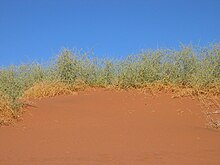Nara (plant)
| Nara | ||||||||||||
|---|---|---|---|---|---|---|---|---|---|---|---|---|

Nara ( Acanthosicyos horridus ) with fruits |
||||||||||||
| Systematics | ||||||||||||
|
||||||||||||
| Scientific name | ||||||||||||
| Acanthosicyos horridus | ||||||||||||
| Welw. ex Benth. & Hook.f. |

The Nara , actually Khoekhoegowab !Nara , ( Acanthosicyos horridus ) is a plant from the family of cucurbits (Cucurbitaceae). Only one other species, Acanthosicyos naudinianus , belongs to the genus Acanthosicyos and is widespread from Angola to the Cape Province in the Namib .
Origin of name
The Nara is also known under the name Nara fruit or Nara melon and takes its name from the native Nama - and Damara , which they call ǃNara . The "ǃ" stands for a click of the Khoekhoegowab .
Occurrence and location
The Nara is endemic to Namibia and grows in a 40 to 60 km wide strip on the 1000 km long coast from the Oranje in the south to the Kunene in the north. Within this area, it occurs only on the banks of rivers and on dunes when its roots can reach groundwater. The population is estimated at a few hundred to a few thousand specimens, although their number and the size of the fruits have decreased in recent years. The Nara is the most common plant in the Namib Desert. Based on fossils , it is believed that the species has existed for 40 million years.
description
The Nara is a leafless, heavily branched and thorny shrub that reaches heights of 0.5 to 1 m. It forms a very deep tap root . The trunk and branches are finely grooved. It is covered with paired, 2 to 3 cm long thorns, which arise from reduced leaves to minimize water loss. The photosynthesis takes place in their branches, flowers and thorns.
Its wild undergrowth of twigs can cover an area of up to 1500 m 2 and it can live for over 100 years. This scrub collects sand and thus forms high dunes , whereby most of the plant is hidden in the sand, where its roots, which are up to 30 cm thick and 40 meters long, reach the groundwater.
The Nara is dioecious, separate sexes ( diocesan ), so there are male and female plants. The five-fold flowers with a double envelope arise in the armpits of the thorns. The chalice is bell-shaped. The green-yellow or greenish flowers are about 3 cm in diameter and appear individually. The chalice is short with five small, leathery lobes. The corolla is thick and leathery with five ribbed lobes. The single appearing female flowers can be recognized by their subordinate, prickly ovary below the flower cup and the long staminodes. The male flowers, with up to five petaloid stamens and a pestle, appear individually or in groups.
It develops first green, later orange-yellow, melon-shaped, bumpy-prickly berries . The high water content fruits reach the size of ostrich eggs with a diameter of about 15-20 cm, with a weight up to 1 kg, they contain about 250 seeds. The seeds lie in a yellowish-orange pulp that contains oxalate crystals . The cream-colored, hard, smooth seeds have a nutty taste and are rich in oil (around 55%) and protein (around 30%). They are elliptical and up to 16 mm in size and flattened. The thousand grain mass is about 385 grams.
The fruit is consumed by many Namibian animals, including giraffes , gemsbok , rhinoceros , jackals , hyenas and various beetles. Mainly elephants and also porcupines contribute to the spread because they excrete a large part of the seeds undigested. Smaller rodents with a high energy requirement such as the gerbil, on the other hand, mainly eat the nutritious seeds and are disadvantageous for the plant.
use
Both the fruit and the seeds (preserved by drying) are suitable for human consumption. In Namibia , the plant is also used medicinally against stomach pain, to accelerate wound healing and as a natural sunscreen.
Remarks
- ↑ Note: This article contains characters from the alphabet of the Khoisan languages spoken in southern Africa . The display contains characters of the click letters ǀ , ǁ , ǂ and ǃ . For more information on the pronunciation of long or nasal vowels or certain clicks , see e.g. B. under Khoekhoegowab .
literature
- Felix Hebeler: Structural and ecophysiological shoot features of the leafless cucurbit Acanthosicyos horridus, a keystone endemic of the Namib desert. Diploma thesis, Justus Liebig University Giessen, 2000, online (PDF; 3.25 MB).
- Acanthosicyos horridus from PROTA, accessed on October 25, 2018.
- R. Hansel, K. Keller and others: Hager's Handbook of Pharmaceutical Practice. Drugs: A – D , 5th edition, Springer, 1992, ISBN 978-3-642-63468-0 (reprint), p. 44 f.
- Transactions of the Linnean Society of London. Vol. XXVII, 1871, t. 11, 11A, online at biodiversitylibrary.org, accessed October 27, 2018.
Web links
- Acanthosicyos horridus from Useful Tropical Plants, accessed October 25, 2018.
- The Nara fruit on namibweb.com (English).
- Description on ecocrop.fao.org (English).
- Naras in the picture collection of the German Colonial Society in the University Library Frankfurt am Main, ( German Colonial Lexicon from 1920).
Individual evidence
- ↑ a b c d Brigitte Osterath: Nara and Welwitschie - the wonder plants of the Namib Desert. In: DW. September 18, 2017, accessed March 15, 2020 .